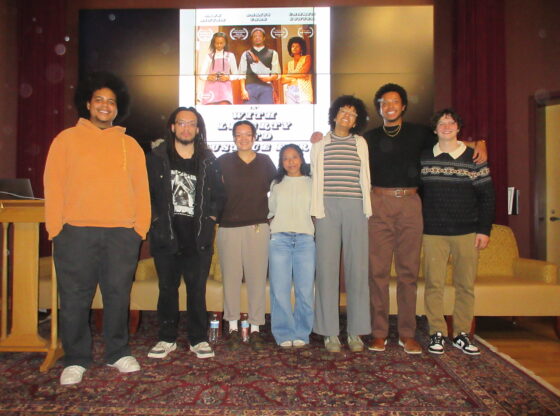In June of 2009, Eric Knudsen posted a series of black and white images for a photoshop contest to the forum Something Awful. The photographs were of children playing in the woods and on playgrounds, but if you looked closely, standing nearby was a tall, faceless man in a black suit. With the photographs there was a caption, transforming the blurry, pale figure named Slenderman, into a myth which at the fingertips of millions, multiplied into an Internet sensation.
In the caption Knudsen wrote, “we didn’t want to go, we didn’t want to kill them, but its persistent silence and outstretched arms horrified and comforted us at the same time.” Five years later, two twelve year-old girls in Waukesha, Wisconsin lured their best friend into the woods and stabbed her nineteen times. The victim miraculously survived. The two girls say that it was a sacrifice to Slenderman.
On Monday June 23, HBO released the documentary “Beware of the Slenderman” which tells the story behind this bizarre case. A large part of the film focuses on the defendants, Morgan Geyser and Anissa Weier, as well as their families. The other part is a study of the motivator behind the crime, Slenderman, and the power the internet can have over today’s youth.
Slenderman’s white, empty face has, for years now, been a blank slate open to interpretation and projection. He is essentially a silent character who has been spoken for by millions—a collaborative urban legend. People use him as a medium through which they can express their fears. In this way Slenderman is not merely a monster, he is also a companion and a protector. He is a door through which individuals who are rarely acknowledged by those around them enter into a world where people accept them. They need only to believe.
For these two Wisconsin girls, Slenderman was far from fictional. He was an omnipotent creature. He was to be feared, and also revered. They attempted murder that day, in order to become “proxies” of the Slenderman. When asked why she wanted to kill her best friend, Morgan Geyser responded dryly, “It was necessary….I was afraid of what would happen if I didn’t.” Geyser and Weier had convinced themselves that if they didn’t kill this girl, Slenderman would kill them and their families.
While interviewing their parents, the film plays home-videos of the defendants, intending to instill within the viewer a similar confusion that the parents were experiencing as they tried to process the incarceration of their sixth-grade daughters. The footage displays two little girls who are happy and loving. They do not appear to display any violent tendencies or psychotic behavior. Their parents insist that all they saw were kids with active imaginations, like many their age.
The documentary, while undoubtedly fascinating, is a tragedy. Slenderman is a character who speaks to the lonely, the afraid, the misunderstood and the curious. According to the myth, the tall character preys on children, but after observing the following he acquires, it is clear that what he truly preys on is the vulnerability of adolescence.
The charge is attempted first-degree murder. Geyser and Weier will be in court again at some point this year. They are being tried as adults despite the best efforts of their lawyers to have them tried as children so that instead of the sixty-five years in federal prison that they are now facing, they would be released once they turned eighteen. Anissa is being held in a Wisconsin county jail for juveniles and Morgan is being held at a state hospital where she is being treated for schizophrenia.
For some, the line between fantasy and reality is not so easy to make out. And in this instance, two girls, both lonely and isolated from their peers, found a common ground, a tall faceless man in a black suit. This commonality clearly strengthened Morgan and Anissa’s belief, so much so that they brought the horrors of Slenderman to life.
The documentary cunningly orchestrates the many layers of the complex story. The viewer is transported from a small, midwestern town where all seems safe and friendly, to a bleak and mysterious landscape where children are lead by faceless men to perform deadly acts. The compelling film enlightens and disturbs, encouraging the world to question the benefits of children being exposed to the internet and its many dark corners, when their minds are so vulnerable.











